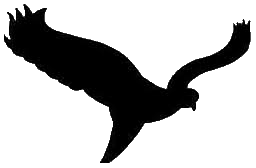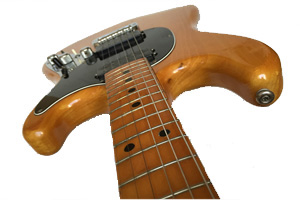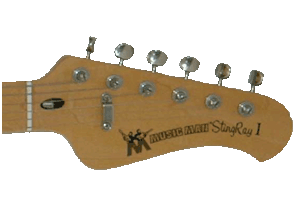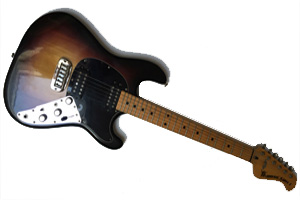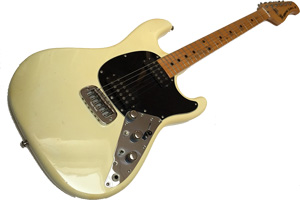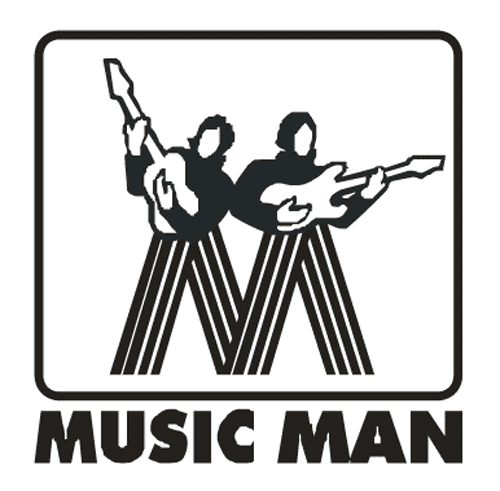
In 1971 some "dissatisfied" Fender employees (Tom Walker and Forrest White) started their own company. After some name changes it finally became "Music Man" in 1974. Their former employer Leo Fender has since intervened in designing and building the amplifiers and guitars. At the end of 1979 he stopped his activities with Music Man. In the early 1980s, the company was taken over by Ernie Ball, indeed the well-known string manufacturer. In the early 80's I bought a 2nd hand "Music Man Saber I". After "dissecting" the instrument, I was positively surprised at the quality of the materials and especially the accuracy of how everything was put together. The bridge, for example, was not a curved piece of metal like you would find with a Fender, but consisted of a metal block that was partly sunk into the body. The neck fits tightly into the body, and the 3-point mounting was reliable. The disadvantage of this Music Man is its weight, as you found with more guitars (including the Fenders) from the 2nd half of the 1970s.
The Music Mans were equipped with active electronics and there was a recess for a 9 volt battery on the back of the body. I think this has not contributed to the acceptance of both the Stingray and the Saber. Not that the electronics (at that time) were not good, but because I think the guitarist didn't handle them well. With passive instruments, set the knobs to 10 (volume / tone). With the active Music Man you have to set the controls (volume, treble and bass) to about position "5". Then the guitar sounds fine. When someone tried my Saber, I saw that the knobs were turned out full, after which people were not very enthusiastic about putting the instrument aside again. "A lot of power", was the response. Compare it to your audio at home or in the car where you put everything in full, and then be amazed at the thumps and sharp tones from the speakers.
I and II variants exist for both the Stingray and the Saber. The only difference is the radius of the fingerboard, or the roundness of the neck on the side where the frets are. The I has a 12 inch radius, the II has a 7.25 inch radius. 7.25 "was the standard of the old Fenders at the time. Modern guitars now often have a flatter 9.5", 10 "or 12" roundness.
Music Man Stingray I - 1977
Transparent polyester gloss lacquer on an ash body and everything still in near mint condition. A Stingray has a 4-position switch with which the following settings are possible: 1. bridge element, 2. neck element, 3. both elements in-phase or 4. both out-phase. The circuit board with the electronic components on it is cast in a kind of epoxy to make it more difficult to find out the circuit and components used. Something that was still done at the Saber afterwards.
The first 500 Stingrays can be recognized by a white pickguard and black plastic buttons for volume and tone. This is already from the next series and has a black pickguard and completely chrome-plated buttons.
As is the case with the Saber, you can provide the built-in electronics with voltage using the 9-volt battery in the back of the body. Neck has the 12" radius.
Body 06-03-1978, Neck 16-09-1977.
Music Man Sabre II - 1978
The paint is already "yellowing" with this copy.
The 4-position rotary knob of the previously published Stingray was replaced at the Saber by a conventional 3-position switch, with which both elements could be switched separately or in combination. The in / out phase and the brightness could also be controlled with two small switches. Neck has the 7,25" radius.
Body: Aug 18 1978, Neck: Aug 17 1978.
Music Man Stingray I - 1978
According to the previous owner who purchased this white Stingray in America in 2006, this guitar was still owned by the original dealer at the time. The instrument had fallen off a rack store in the early days, causing a piece of lacquer to pop off the bottom. Therefore, the guitar was withdrawn from sale and then forgotten.
Body: Sept 1977, Neck: Sept 1978.
Music Man Sabre I - 1978
My first Music Man I got when I took over from someone in the early eighties. The neck was then refreted (beautifully done by Gijs de Wit) and the nut was then immediately replaced. The reason the frets were replaced had nothing to do with wear and tear, as the guitar had barely been used. However, there was a problem with one of the frets, so it was decided to replace everything to avoid any difference.
Date on the neck: 11/16/1978.
Music Man Sabre II - 1979
A white (but now somewhat yellowed) Saber with clear traces of use.
In the early 90's I came across this in the occasion rack of a music store. At that time, the adjustment was such that it was almost impossible to play, but I did see possibilities.
The neck says: Feb 8, 1979.
